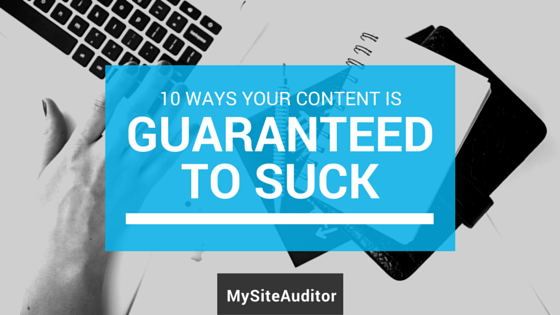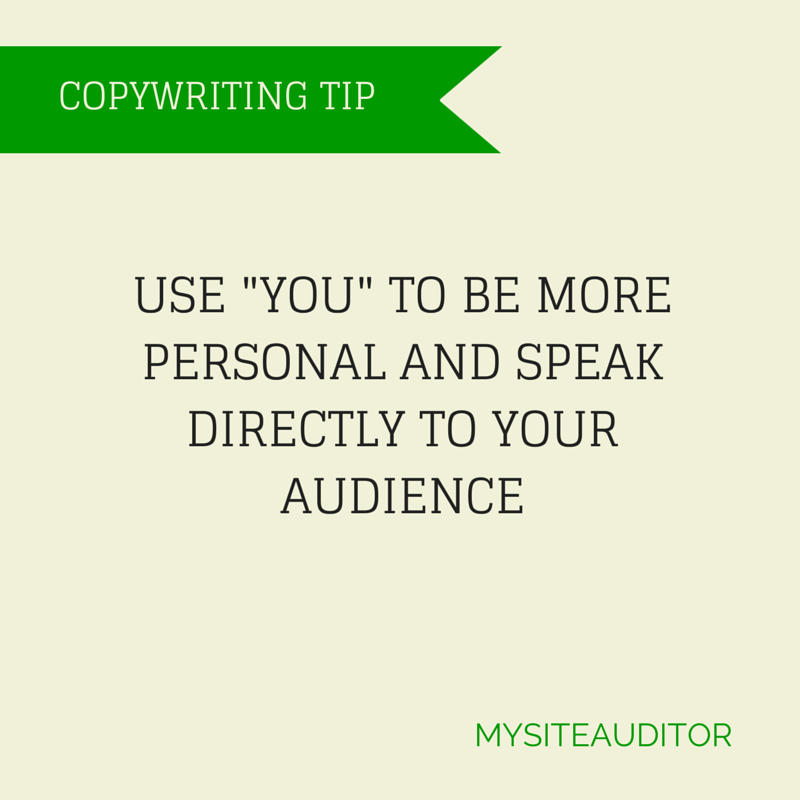- Free Download: New Web Design Client Questionnaire - October 1, 2015
- The Beginner’s Growth Hacking Guide for Agencies - September 14, 2015
- 23 Creative Content Syndication Ideas - September 2, 2015
When content is done right, it is an extremely powerful tool for driving traffic to your website, building your brand awareness and authority, and converting leads into sales.
But, just because you create it doesn’t mean it’s good. Countless blogs and articles are published online every day that nobody ever reads because, well, they suck.
So, how do you know if your content is doomed? Here are ten ways your content is guaranteed to suck – and how to improve it.
1. It’s inauthentic
In the modern world of web savvy readers, content that’s trying too hard is guaranteed to flop. Your visitors can easily see through your thinly veiled attempts to sell them your product or services via poor content, and will immediately bounce for better content elsewhere. Every minute of every day new content is published online, and inauthentic content is ultimately just a large waste of time and effort.
How to create authentic content
However, you can make yourself stand out from all the noise by being truly authentic. Here are three quick ways to create content that rings true with your specific audience:
Attribute authorship: people want to engage with people. Make sure you’re not publishing under “blog admin,” but rather leveraging your team members as blog authors. Everyone in your company has a unique background and useful insight to share. For every post, include an author name, photo, unique bio, and links to their twitter and linkedin profiles.
Here’s a good example, via HubSpot:
Listen and engage with your audience: Don’t just talk at your readers thinking you know what they want. Your content should spark a conversation, so pay attention to blog comments, and respond to them genuinely. Pose questions in your content to generate responses, and continue the conversation on social media.
Find balance between content creation and curation: Sometimes sharing others’ content is the best route to creating trust and rapport with your audience. Including relevant external links within your blog content or sharing useful videos or infographics from other sources shows your audience that you’re not just focused on yourself and that you want to provide actual value to them.
2. It’s not actionable
There’s a reason why the most popular content on the web these days is how to’s, informational list posts, and robust downloads and guides – these types of content make readers’ lives easier! Make sure your content contains key takeaways and practical tips for your readers that they can use in their personal and/or professional lives.
Here’s the difference: it’s one thing to write a blog post about how anyone can create a website on their own and what to include on their site. It’s another to give them actionable free tools with which to do so.
3. It’s not visual
Visuals are imperative to making your content more digestible and engaging. What’s more, visuals aid in decision making, are more persuasive, and lead to longer overall impressions. But I’m not talking about using run-of-the-mill stock photos, because everyone everywhere has been there, done that. When crafting unique content, include varied custom visuals that help make your point and make you stand out from the crowd. If your readers get bored with your copy or while reading longer pieces, you can ensure you still convey your message and pique their interest as they skim the visuals.
Ways to make your content more visual
- Use charts, graphs, and infographics to convey statistics.
- Create custom, social-media specific graphics to make your content easily tweetable and pinnable, like quote images
- Avoid obvious photography – think more abstractly and conceptually when choosing photos to accompany your blog posts. For example, if you were writing for a business or financial services firm, it might be easy to rely on generic stock imagery, such as the dreaded stock handshake photo below:

 Instead of such a literal image, opt for a more emotionally evocative and conceptual image, like a mountain scene. Both images convey overcoming obstacles and growth, just in very different ways.
Instead of such a literal image, opt for a more emotionally evocative and conceptual image, like a mountain scene. Both images convey overcoming obstacles and growth, just in very different ways.
4. It’s not relevant
Make sure you know who your audience is, and what they care about. If you have buyer personas created, great. If not, consider what stage of the buying journey your reader is in, and think about what type of content would enhance their experience. Take a look at what your competitors are doing, and make it better by reflecting your unique voice.
Remember, content doesn’t have to be just written content – if you have a younger audience, perhaps staying relevant means producing video content or creating infographics instead.
5. It’s overly promotional
When your content is always focused on your brand, it’s easy for potential customers to write you off as another meaningless advertiser. Endless press releases and blog posts solely focused on your CEO or company updates will quickly bore users, and won’t turn leads into conversions.
That’s not to say that some brand focused content is useful – it is. But shifting your strategy from being brand-focused to consumer focused is far more worth it. The key is finding the right balance of the two. Rather than make a hard sell with every piece of content, work in useful resources and industry news. Variety is the spice of life, right?
Here’s an example: if you’re a company that sells social media software, your content strategy could include:
- Free downloads and/or guides that help your customers understand the audiences on each social media platform
- Blogs providing your CEO’s and engineering team’s insight on relevant industry trends
- A free pack of cool graphics for your customers to amplify via their social media channels
6. It’s boring
If your content reads like a fifth-grader’s 5 paragraph essay, you’re in trouble. There are tons of resources on copywriting 101 out there, but here are some essentials to writing compelling copy:
Write good headlines. Arguably THE most important part of your post, your headlines should be to the point, personal (use “you” to speak to your reader directly), and exciting!
Be direct. Communicate clearly by cutting to the chase and opting for short sentences over extra words.
Spur action. If your content isn’t convincing a reader to convert, it’s failing. Encourage readers to take action by instilling a sense of urgency (“now is the time!”) and including direct calls to action.
7. It’s formatted poorly
The best content out there makes use of good formatting to entice readers to stay on the page. If you put the thought and effort into formatting each blog post or piece of content you create, your analytics will reflect lower bounce rates and longer time spent on page, both important engagement metrics you and your clients should be paying attention to.
Some quick formatting tips:
- Use headings, subheadings, and bullet points to break up huge blocks of text
- Include a featured image at the top as well as images within the body
- Include social media share buttons (preferably with counters that provide “social proof” that your piece is valuable)
8. It’s not promoted
Your content is only good if people see it. You should absolutely make sure you focus on generating organic traffic to your post (see next point!), but also make use of promotional vehicles like social media to start conversations on your content’s topic.
But, don’t just automate promotion by blasting out the title on all your social outlets at once – take the time to engage each different audience with intention. For example, the way you frame an article on LinkedIn and Twitter should be very different.
9. It’s not optimized for search engines
Blogs are a great way to drive organic search traffic and reach more customers. But, getting your blog posts and content to rank higher in search engines requires some work. These SEO checklists will help you cover all your bases before you publish, but here are a few first steps:
- Make sure your blog follows proper url structure
- Use keywords organically and thoughtfully throughout your content, and focus on long-tail key phrases with low competition
- Make sure your meta description, title tag, and headline all include your target key phrase
- Optimize your images by adding image title tags that contain your keyword
Plus, here’s a great infographic on the Anatomy of a Perfectly Optimized Page for your reference.
10. It’s not strategic
Are you writing content based on your mood that day, or are you aligning it with a defined content strategy based on your business goals? If you don’t have a well-conceived strategy and an editorial calendar in place, stop reading this and go make one.
Ask yourself a few questions to make sure you’re being strategic with your content:
- Do I know who my audience is?
- What do I want readers to do after they read this content?
- Will readers share this content?
Conclusion
So, you’ve created bad content in the past. Let bygones be bygones. Now get to creating the good stuff based on the above, and start seeing the results you want.
Any other advice out there for not sucking at content? Leave us a tip in the comments!





